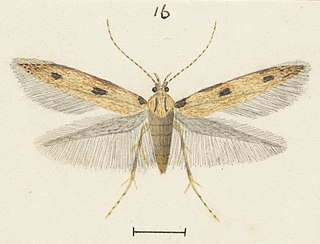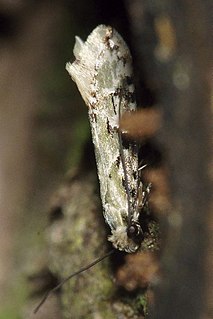
Halpe homolea, the Indian ace or Ceylon ace, is a butterfly belonging to the family Hesperiidae.
Agathactis is a genus of moths in the family Gelechiidae. It contains the species Agathactis toxocosma, which is found in Guyana.
Barticeja is a genus of moths in the family Gelechiidae. It contains the species Barticeja epitricha, which is found in Brazil and Guyana.
Flexiptera is a monotypic moth genus in the family Gelechiidae erected by Anthonie Johannes Theodorus Janse in 1958. Its only species, Flexiptera revoluta, was first described by Edward Meyrick in 1918. It is found in South Africa.

Pyrausta purpuralis is a species of moth of the family Crambidae. It was described by Carl Linnaeus in his 1758 10th edition of Systema Naturae and is found in Europe. The species closely resembles Pyrausta aurata and Pyrausta ostrinalis. It is also known by the common name Common Purple & Gold.

Scoparia ambigualis is a species of moth of the family Crambidae described by Friedrich Treitschke in 1829. It is found in Europe and Asia Minor and possibly in Guangdong and Shanxi in China.
Crocogma is a genus of moth in the family Lecithoceridae. It contains the species Crocogma isocola, which is found in India (Assam).
Technographa is a genus of moth in the family Lecithoceridae. It contains the species Technographa ephestris, which is found in Sri Lanka.

Heterocrossa iophaea is a species of moth in the family Carposinidae. It is endemic to New Zealand.

Labdia anarithma is a moth of the family Cosmopterigidae. It was described by Edward Meyrick in 1888. It is found in New Zealand and throughout Australia. Adults are on the wing from December to March and are day flying. They have been collected by sweeping bracken fern.
Helcystogramma epicentra is a moth in the family Gelechiidae. It was described by Edward Meyrick in 1911. It is known from Sri Lanka and China.
Rhopalosetia is a monotypic moth genus in the family Copromorphidae. Its only species, Rhopalosetia phlyctaenopa, is found in French Guiana. Both the genus and species were first described by Edward Meyrick in 1926.
Araeovalva albiflora is a moth in the family Gelechiidae. It is found in South Africa.
Gelechia epiphloea is a moth of the family Gelechiidae first described by Edward Meyrick in 1913. It is found in South Africa.
Demiophila is a moth genus in the subfamily Autostichinae. It contains the species Demiophila psaphara, which is found in Sri Lanka.
Cophomantella furnaria is a moth in the family Lecithoceridae. It was described by Edward Meyrick in 1913. It is known from South Africa.
Eclecta is a monotypic moth genus in the family Depressariidae. Its only species, Eclecta aurorella, has been found in the Australian state of New South Wales. Both the genus and species were first described by Edward Meyrick in 1883.

Crypsitricha mesotypa is a species of moth in the family Tineidae. It was described by Edward Meyrick in 1888. This species is endemic to New Zealand.

Tingena eumenopa is a species of moth in the family Oecophoridae. It is endemic to New Zealand and found in the North and South Islands. The adults have been found amongst tree ferns and are on the wing in December.

Tingena hemimochla is a species of moth in the family Oecophoridae. It is endemic to New Zealand and has been observed in the North Island. Adults of this species are on the wing from December until March.







